#this is all things considered a very small and ultimately optional (iirc) part of this game
Explore tagged Tumblr posts
Text
i find myself really intrigued by the Moral Implications of recruiting Fodoquia in Unicorn Overlord. Under the cut for both spoilers and discussion of dark topics like Child Death/Child Murder
Because like, in almost every other optional recruitment situation, sparing the person instead of executing them (even when they probably deserve it) is presented as the Altruistic option. After all, theoretically Alain isn't here on some grand conquest on the basis of My Way Or The Highway but rather greater liberation for all of Fevrith, which would be undermined if he needlessly killed people who had surrendered to him. We can see this in examples like Auch, Mordon, Melisandre, Jerome, etc.
But the situational context of Fodoquia's recruitment are entirely different. After you defeat him, he tells you the story of how his child son was kidnapped and brutally murdered by his subjects for not bending the knee to Zenoira and inadvertently subjecting them to siege conditions, and rather than executing him and allowing him to "reunite" with his son in death, Zenoira instead forced him to defend the town in their name. None of this context is provided to the player until after they've defeated him in battle, as he lays dying before Alain in defeat. He expresses bittersweet relief that, at last, he can finally see his son once more, and Alain has the option to allow him to do so and pass away.
Or. Instead. He can have Scarlett heal his injuries and recruit him into the liberation, saying "Not when you can still honor [your son's memory]". Afterwards, the only reaction Fodoquia has is to say that "It appears his mission is unfulfilled" before joining you. And, while there's a chance I'm reading too much into it, to me Fodoquia joining the Liberation has clear parallels to the exploitative situation he was just in for Zenoira. Which is so deliciously fucked to me.
The difficulty curve spikes when the player arrives in Albion, with stronger enemies and more complex battle maps, which incentivizes the player to find as many high-level recruitable characters as possible, which encourages the player to recruit him. And usually, in most situations, not killing someone is the morally correct answer, right? But in this case, the choice is presented not as sparing him from death, but from denying it from him, regardless of his personal feelings or input on the matter. Once again, Fodoquia is unwillingly (or at least dubiously willingly) put into the service of a foreign army and required to fight for them, once again being denied a reunion with his beloved son. What does that say about the Liberation that their methods so eerily reflect those of Zenoira? Are we truly the "good guys" we claim to be? Can there be "good guys" in war? How dire has the situation against Zenoira become that something like this is deemed necessary?
Idk it just really affected me the first time I played it, and on my "spare nearly everyone and be as good of a guy as possible" playthrough I appreciated that they were still able to have some questionable moments where the answer isn't as clear cut.
#child death cw#this is all things considered a very small and ultimately optional (iirc) part of this game#and i wouldn't be surprised if i'm thinking about this more than the developers did#but the fact that Fodoquia also has very limited rapport with characters beyond Alain really kinda hits it home to me.#having said that i have not unlocked or seen most of those rapport conversations#so it is possible that there's something in them that completely contradicts all of this ^^;;;#i think i just appreciate a situation where sparing the person isn't the 'wrong' choice bc they're a bad person and they deserve to die#but bc at this point death may be the kinder option#plus like most of the other recruitments have Alain 'spare' them by just. not executing them (passive)#whereas this one has Scarlett heal him from death's door (active)#which makes it seem less altruistic to me bc like#the liberation already beat him. he's already dying and it's not like they had no part in that#so to me it reads more as cold practicality rather than genuine kindness#and even if it does stem from a place of kindness the actual actions still mirror zenoira#anyway. i finished this game last week and i think this is one of the sidequests that stuck with me the most#marie speaks#unicorn overlord#unicorn overlord spoilers
3 notes
·
View notes
Text
Sentinels of the Multiverse: Adelphophage’s archives (part 4: Shattered Timelines/Wrath of the Cosmos villain promos)
Welcome all to Chronos Casuals. I’m ChronosMysty and today I’ll go over the last of the villain promos and the gauntlet.
Deadline: Angel of Extinction
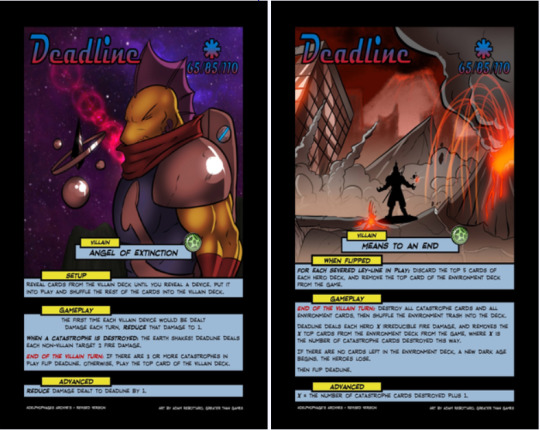
This new Deadline is very much similar to the old deadline, only with a few extra quirks. • His devices are harder to kill. • Catastrophes being destroyed while he is on his front side causes deadline to deal 2 non-villain AOE fire damage. • Severed Ley-lines accelerate the environment destruction but are also less detrimental to trash-based heroes. • H-scaling health Moving on.
The Dreamer

The first half of the Dreamer fight plays very similar. The second half, however, has a tempo-regulating system that “rewards” heroes doing well with more projections (which is technically good, since the goal is to chew through them as fast as possible) but lays off on the extra projections if you’re a little slow on the projection destroying. (Do note that you’re still better off destroying them fast if possible.) My only gripe was that I played a game where I ended up seeing pretty much all the projections in the first half and the second half was mostly spent revealing duds (not to mention that shuffling back in the duds only increases he probability of hitting duds in later reveals, at least theoretically). The 3 Violent Nightmares in the deck are there to help prevent these situations, so I don’t think I would recommend changing it to discard them, this was just an off situation. (Then again, old Dreamer could encounter very similar situations, so that’s just an inherent problem of the deck.) Only thing I could think of is maybe adding an end of turn ability or adding to the start of turn ability (either before or after), “If there are no projections in play, shuffle the villain trash into the villain deck” or even just the projections, but that’s quite a bit more to keep track of an unlikely payoff that I’m not sure it would be worth it.
Infinitor
There isn’t one for Infinitor. Honestly, base infinitor is in a pretty good spot (although ally infinitor is ridiculously easy except in challenge or ultimate mode).
Iron Legacy: Justice for All
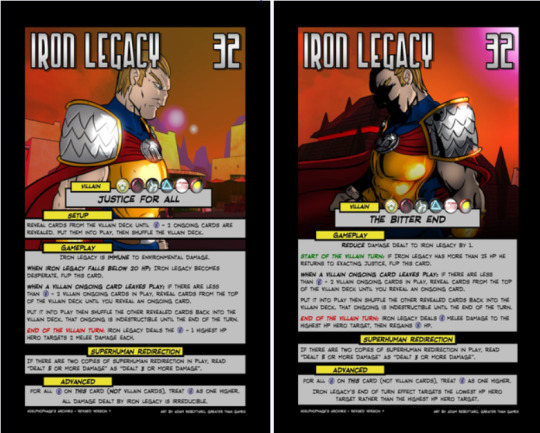
Oh boy, Iron Legacy. out of the three most difficult bosses pre-vengeance, at least iron legacy was kind enough to kill you or die within like 10 minutes.
The first thing you’ll probably check is whether the end of turn effects do less damage, and the front one certainly does (the back one does more IIRC but now targets the highest HP unless playing on Advanced. It also heals 1 point less IIRC.)
The second thing you’ll check and notice and is that his H-scaling mechanic revolves around H-2 Ongoings: he starts with that many (rather than H), but you’re probably not going to get him to less than H-2 Ongoings. Overall, he still hits like a ton of bricks and not being able to clear out all his Ongoings makes him a persistent threat, but those two fewer Ongoings at the start really do make a huge difference in making him beatable.
Kaargra Warfang: Ruler of the Pit
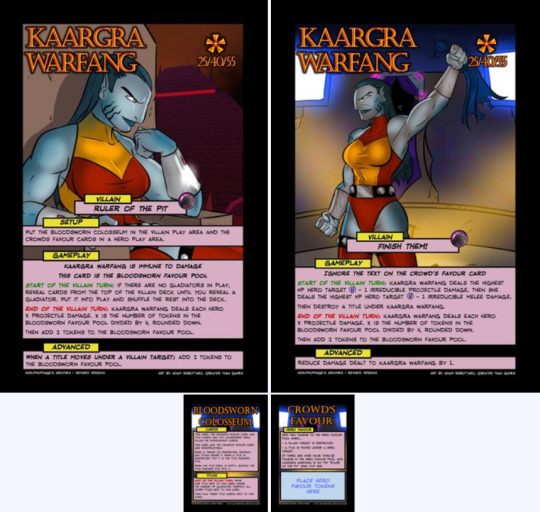
Remember what I said about Iron Legacy making the game nice and quick? yeah, Kaargra Warfang didn’t play like that. I think I can say without exaggeration that old Kaargra Warfang has more bookkeeping than OblivAeon.
I’m guessing you probably can’t read the altered Crowd’s favor and Bloodsworn Coliseum, so I’ll just type out their texts, with my commentary in parantheses and italics. Bloodsworn Coliseum [Cards] This card, the Crowd’s favour card and Title cards are not considered hero, villain or environment cards. (And apparently, the Oxford comma isn’t considered a thing either.) This card and the Crowd’s favour card are indestructible. When a target is destroyed, destroy any Titles under it. When a title is destroyed, put it in the title discard pile. (You mean Title Trash?) When the Title Deck is empty, shuffle the title discard pile into it. [Titles] End of the villain turn: Move one Title next to this card under the highest HP gladiator. Destroy all other titles next to this card. Then play Title cards until there are 3 titles next to this card.
Crowd’s Favor [Hero Favour] Add two tokens to the hero favour pool when... • a villain target is destroyed • A title is moved under a hero target If there are ever 4xH tokens in the hero favour pool and Kaargra Warfang is on the “Ruler of the Pit” side, flip her. (And she will then proceed to require you to ignore the text on this card and make it almost irrelevant except when Fickle Fans happens.)
You may notice that ability to gain Titles only happens 3 at a time and the gladiators can get one of them that you didn’t win during the previous round. You may notice that the purpose of Crowd’s favor is to get kaargra to get off her chair and into the fray so that you can beat her down to win. You may notice a complete lack of referencing bloodsworn pool tokens among those two above cards and ask, "Are they still relevant?” The answer: yes. At the end of the villain turn, kaargra deals each hero x projectile damage, where X is the number of tokens in the bloodsworn favour pool divided by 4, rounded down, and then adds 2 tokens to that pool. You’ll also notice that she’s a target that’s immune to damage. that’s pretty much just to avoid her flipping prematurely. This does have some other interactions, but a safeguard on the back side helps stop it from being too relevant.
Overall, the play experience is much more enjoyable and feels decently beatable if you get a good set of titles early on.
Kismet: Twist of Fate
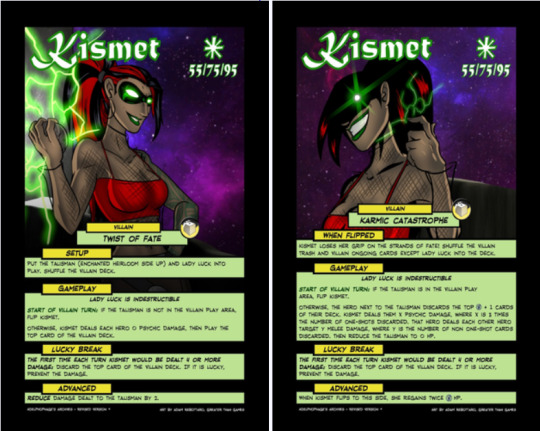
Old Kismet was a great idea done poorly - it’s clear she wants to keep the Talisman, but it’s so easy to take it away from her and use it against her that the fight just doesn’t go anywhere. Her unsubtle trickster promo is fascinating, but it still hinges on the idea of giving the heroes an extremely useful power and giving them the option to attack it and put it back to get it a few turnslater on a different hero. This idea is quite different from either of those. Here, Kismet builds up power with Jinxes and releases a (usually small) AOE attack every turn. An indestructible Lady Luck makes destroying her Ongoings very unreliable. The talisman acts as the kill switch, as using it will put back all her non-Lady Luck ongoings, trigger a rather large AOE, give her back the Talisman at full health. The game becomes managing a cycle of jinxes and AOEs vs the potential massive burst damage. Oh yeah, and for some reason, she is somewhat reliably unable to be hurt by large damage attacks.
The battle is an interesting and unique experience, albeit a little frustrating when you’re trying to destroy an Ongoing when Lady Luck says “nope”.
La Capitan: Paradoxical Pirate

La Capitan has always been a fiddly battle. This version helps a lot with this, but it doesn’t make it stable.
First thing to note is that the Timeship actually plays a very different role in this fight, with its actual abilities rarely ever used, instead mostly just being a marker for whether the back side can deal damage or not. Additionally, Raiding Party triggering the end of turn clause that flips her and skips all other ‘end of villain turn’ clauses ensures you don’t get overly swarmed.
Honestly, I don’t have much to say about this fight. I still don’t enjoy this villain, but it’s better than the official card.
Progeny: The Messenger
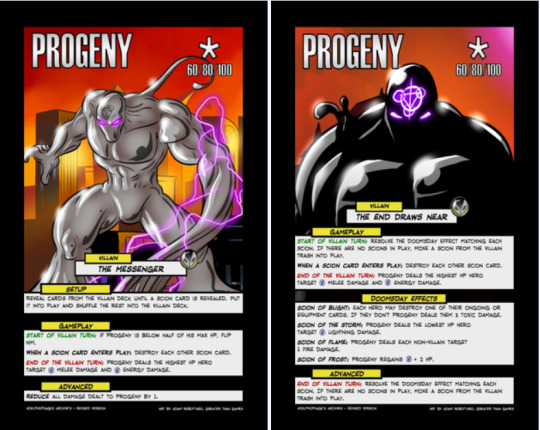
I always found Progeny boring, due to it basically being the same fight throughout with little variation. This variation helps a bit, but overall, I still find it boring.
To go over the differences: • There’s only at most 1 Scion out at a time, generally. This actually fits a lot more flavor-wise. • The end of turn effect deals two instances of H to the highest HP hero target rather than 2 AOE, making him much less susceptible to damage fluctuations. (1 DR still has its place, though, as a number of cards in the deck deal damage in chunks of 1.) • he now flips in the middle of the fight in a mechanic very similar to Dark Souls’ heat-up, gaining an additional ability based on the current Scion.
And, yeah, that’s about it. It’s also cool to note that his health is 20xH, which makes sense given how most of his damage is sort-of H-based, either directly or indirectly.
And rather than change each vengeance villain, why not just change the rules of vengeance style entirely? Here we go:
The Gauntlet
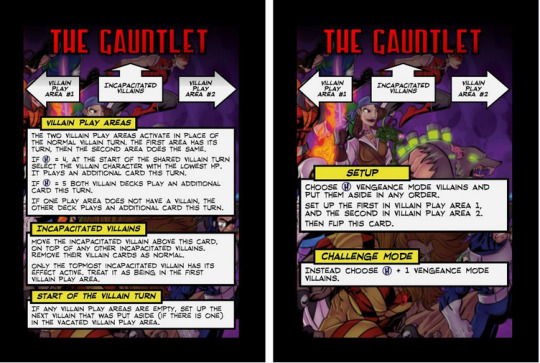
This is an alternative to regular Vengeance play, in which the basic idea is that you only fight H of them, but only two at a time and they both “share” a turn at the start of the turn order. Additionally, they’ll collectively play H-1 cards per turn, keeping the pressure up.
Honestly, at H=3, you might as well play a regular vengeance game, although I can still see the appeal of using this gauntlet format. H=4 is quite fun. H=5 is soul-crushingly difficult, watching a new villain step in completely refreshed while you’re getting battered.
Anyway, my plan is to next look into the unique decks I have played against in Adelphophage’s archives, but before that, I’ll be making one more post soon after this one. I’ll see you all next time, and remember, keep it casual!
1 note
·
View note